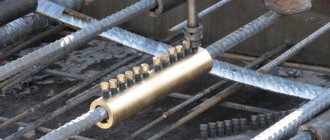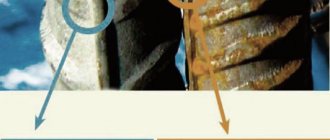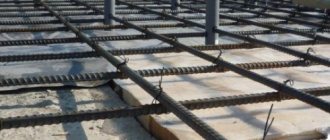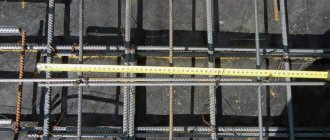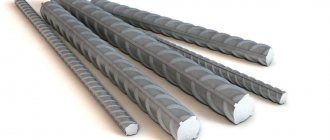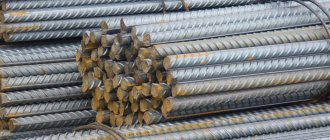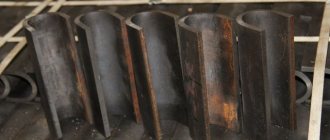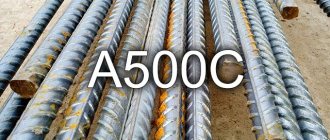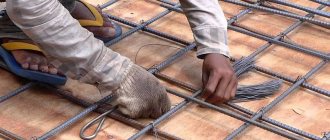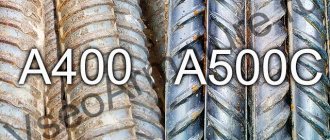One of the important tasks of modern monolithic construction is the reliable joining of load-bearing metal reinforcement. If previously welding assembly and overlapping strapping were used for connections, now mechanical coupling fastening is being introduced everywhere. Construction technology using reinforcing couplings is in demand for the construction of buildings with increased load-bearing loads: multi-storey buildings, hydroelectric power plants, bridges, as well as in seismically unstable areas.
Connecting couplings for fittings
One of the important tasks of modern monolithic construction is the reliable joining of load-bearing metal reinforcement. If previously welding assembly and overlapping strapping were used for connections, now mechanical coupling fastening is being introduced everywhere. Construction technology using reinforcing couplings is in demand for the construction of buildings with increased load-bearing loads: multi-storey buildings, hydroelectric power plants, bridges, as well as in seismically unstable areas.
Features and purpose
Couplings are often used in combination with other fastening or locking elements:
- limiters;
- valves;
- valves.
The couplings create a high-quality connection because they are made of a material of the same strength as the reinforcing bars.
Scope of application of couplings:
- installation of reinforcement cages during the construction of foundations;
- assembly of metal frames during the construction of multi-story and low-rise buildings, bridges, industrial buildings, power plants.
Couplings for connecting reinforcement are used for fragmentary elimination of joints.
What are couplings?
In the production of parts, small diameter pipes are used - smooth or with microthreads. The material for production is high-quality steel of different grades, depending on the type of fittings. The finished hollow parts have a cylindrical shape. The length of the cylinder ranges from 7-20 cm, and the diameter depends on the thickness of the rod. The walls of the part have a thickness of 2-5 mm. Reinforcement couplings are similar in shape to similar elements used when laying pipelines.
To ensure a strong connection, the shape and source material of the coupling and rod reinforcement must comply with GOST 10922-2012. Regarding the connection of reinforced concrete monolithic structures, they are guided by GOST 34278-2017.
What it is?
The technology for assembling products from reinforcing bars involves the use of couplings. This ensures savings in rolled metal.
There are two main types of couplings:
- threaded (screwing on the connecting reinforcing bars is required);
- crimping (requires special equipment for crimping).
Each group includes several subtypes of couplings, differing in design nuances and joining methods. Installation using threaded couplings ensures strength and less material consumption (savings up to 20%). Unlike the strapping method, it does not increase the reinforcement structure.
Elements are used to directly connect parts. A reliable, cost-effective option for mounting the frame is provided. Standard sizes of couplings, types and parameters of materials used are regulated by GOST 10922-2012.
Connecting reinforcement using a coupling
Purpose and features
With the development of monolithic frame construction technology, couplings have become more in demand.
They facilitate reliable fastening of reinforcement directly in the work area. Installation of the coupling unit takes up to 10 minutes. Does not require specialized equipment or training. The ends of the reinforcement are fixed inside the coupling and then screwed onto the thread or the following fasteners are used:
If you need to connect reinforcement of different thicknesses, positional couplings are used. They are also suitable for cross and straight fastening of curved rods. The cost of assembling the structure is calculated when planning the overall estimate.
Operating principle and design
Depending on the type, couplings have their own design features and methods of application. Small diameter pipes are used to produce couplings. Inside there is a smooth surface (for crimping types) or a pipe microthread with an inch pitch is applied. The outer connecting end is made in the shape of a polyhedron. Threads are created in various ways: rolling, stamping, etc.
Connecting couplings for fittings
The edges of the connected rods are placed inside the coupling, after which they are joined end-to-end by screwing onto the thread and secured with studs. Position couplings are used to connect reinforcing bars of different diameters. They are used for direct and transverse connections of straight or curved reinforcement. The cost of assembling the structure is included in the planning and preparation of the general estimate.
Connecting reinforcement with couplings: pros and cons
The socket connection technology has 5 main advantages over welding and lap joints:
- Speeds up construction speed. Provides up to 500 joints per 1 construction team per shift.
- Allows you to reduce the number of workers due to high productivity.
- Eliminates the need for highly qualified welders, as a mechanical joining method is used.
- Guarantees material savings. The joining of reinforcement and the absence of overlaps eliminates overexpenditure.
- Allows you to increase the height due to the strength and lower weight of the reinforcement in the frame.
Using a mechanical connection, it becomes possible to carry out knurling and installation simultaneously. No additional hardware is required for vertical installation. This significantly reduces the operating time of the cranes.
The disadvantages of mechanical fastening include:
- reduction in metal thickness as a result of cutting, and, as a result, decrease in strength;
- the need for physical effort when tightening the coupling;
- the use of expensive hydraulic presses for crimping;
- high cost of cylinders.
It is worth noting that the costs in this case quickly pay off.
Advantages and disadvantages
Couplings for structural connection of reinforcement have the following advantages:
- multifunctional connection of metal elements in different directions (horizontal, vertical or inclined arrangement);
- the crimp design of the couplings provides a uniform connection by crimping the ends (does not require preliminary threading);
- the construction time of a monolithic structure is reduced;
- the metal frame can be mounted regardless of the parameters of the structure being constructed;
- ease of design quality control;
- no welding work is required, including highly qualified welding;
- the cross-section of metal reinforcement has a small area;
- the load is distributed evenly over the entire area of the structure being constructed;
- for assembling reinforcing elements of metal frames, special tools and equipment are not required (in the case of threaded couplings);
- there is no need for a limit on the coupling connection of the pins.
As a result, the entire structure is a single metal pin. The frame retains its integrity even if the concrete structure is destroyed.
Mechanical connection of reinforcement using a coupling
Disadvantages of a coupling connection:
- reduction in strength and reliability of installation during thread cutting (reduces the overall thickness of the structure);
- screwing on a coupling with an internal gasket requires some physical effort.
The greatest difficulty is the use of crimp couplings. Application features include:
- increase in the weight of the mounted structure;
- the use of heavy hydraulic presses during the installation process;
- the impossibility of repeating the connection even for one casting of rolled metal;
- the deformability requirement is not met.
Crimping fittings is a technology that has disadvantages. Among the main ones is the inability to maintain the declared quality level when operating conditions change.
Types of fastenings
To fix the rods and prevent loosening of the structure, threads are made inside the couplings or crimp rings are installed. According to the type of fastening on the rod, couplings are divided into 2 types:
- threaded, with a thread applied inside;
- crimp, implying the additional use of tightening elements (rings or nuts).
For each method, appropriate preparation and processing of materials is provided.
Installation technology
The algorithm for installing a metal frame using couplings includes several stages.
- The coupling is installed on a pre-marked reinforcement section.
- The holes of the couplings with internal threads are closed with plastic caps.
Coupling installation technology for connecting reinforcement
- The ends of the cut reinforcing bars are covered with rubber caps. For threaded couplings, threads are cut or rolled on the rods.
- Before putting the coupling on the rod, tighten the connection with a wrench.
When connecting with crimp-type elements, special equipment will be required. Technology includes:
- assembly of crimping devices on rods;
- pressing of units using a portable hydraulic press.
Afterwards, a visual inspection of the connections is carried out and their quality is controlled.
Types of connection equipment
The equipment for joining depends on the type of coupling used and the location of work. There are 2 types of machines available: for crimping and threaded fastening.
For crimping under construction conditions, mobile hydraulic presses are used, consisting of: a press, an oil station and high-pressure hoses. The press operates in semi-automatic mode. Control is carried out from a remote control built into the handle or manually.
Using a portable press, mechanical crimp fasteners form a reinforcement joint with high tensile strength. At the same time, the actual force to the temporary resistance of the compressed rolled product increases significantly and unlimited endurance is guaranteed.
Machine for thread cutting on fittings
The machines are designed to prepare joints for subsequent coupling fastening. They are applicable to rods with a diameter of 16 to 40 mm. Provide a maximum thread length at the outlet of up to 80 mm.
Depending on the cutting, there are 2 types of machines:
- For conical cutting. Mechanism of action: removing excess body from the reinforcement with cutters, followed by giving it a cone shape and cutting. Productivity - up to 1000 notches per shift.
- For cylindrical knurling. The reinforcement ribs are cut with cutters, and the notches are rolled with rollers. Can be used directly on a construction site with a productivity of 400 threads per shift.
Crimping machine
The machines provide a complete set of crimping technology. The system connects reinforcement in the range of 16-55 mm. The kit includes replacement dies for different rod diameters. The standard machine consists of the following components:
- Reinforcement press (stationary or portable).
- Pumping station.
- Winch for moving the press relative to the coupling.
- High pressure hose.
Coupling principle
The technological sequence of crimping depends on the location of the work. To connect reinforcing steel at a construction site, the following sequence of actions is followed:
- the coupling is placed at the joint;
- pressure testing is performed;
- visual inspection is carried out;
- a comprehensive check is carried out.
For mechanical threaded connections, small diameter pipes are used. Microthreads of the required diameter are drawn inside the structures, and the connecting ends are formed “turnkey” in the form of a polyhedron. Inch microthreads are applied with the smallest pitch to avoid the teeth from overlapping the pipe walls. In this case, the standard assembly of longitudinal reinforcement consists of 7 stages:
Preparation of equipment and purchase of couplings of appropriate sizes.- Cutting threads at the ends of rods.
- Fixation of reinforcement.
- Screwing to one end of the cylinder.
- Twisting on the other side.
- Tightening the knot to the maximum.
- Checking the build result.
This method does not require a large number of fasteners. Since threading thins the material, thick-walled pipes are used.
Regardless of the type of mechanical coupling fastening and fixation technology, this method is advanced. Thus, the production of one mechanical joint takes 20 times less time compared to welding. The work time of welders is reduced by 90%, thereby eliminating downtime due to lack of personnel. Costs for joining reinforcement are reduced by up to 25%. Connection without welding is a pressing problem in construction.
Source
Results
Joining reinforcing bars with special couplings is an optimal alternative to assembly using the overlap method or welding. This technology simplifies the frame installation process and ensures durability.
Mechanical elements are divided into two main groups: threaded and crimped. Each of them has several subspecies, which have their own manufacturing and installation features.
When using connecting elements, you need to know how corner reinforcement and reinforcement of a pile-strip foundation are carried out. You already know the answer to the question whether it is possible to weld reinforcement for the foundation, as well as the nuances of manufacturing reinforcement cages.
Assembling a metal frame reduces the labor intensity of the process and is used to build up or correct structural elements in the future. There is also an alternative option - plastic reinforcement: the pros and cons of using this material will be interesting to know for those who start construction on their own.
System for mechanical butt jointing of reinforcement using the crimping method with a coupling
IPG Enerprom presents a system of reinforcement presses for crimping rod reinforcement with a coupling.
Coupling mechanical crimp connections, providing a joint with a tensile strength exceeding the actual tensile strength of the joined rolled product and with a guarantee of endurance, do not have the limitations inherent in welded joints and allow solving a construction problem of any complexity.
- Coupling connection of reinforcement – Analysis of world experience in mechanical butt connection of rod reinforcement using crimping of a coupling (Repair Splicing System)
Types of coupling fastenings
Coupling connections involve various options for joining reinforcing bars:
- couplings with conical thread type;
- parallel thread couplings;
Coupling connections for Ancon MBT fittings
- bolt type couplings;
- crimp couplings for fittings.
Couplings designed for connecting metal structures have several varieties:
- transitional (for sequential joining of rods having different diameters);
- bolted (for connecting reinforcement using special friction linings);
- positional (for high-speed connection of reinforcement of various shapes: straight, curved and curved rods).
If couplings without threads are required, crimp options for connecting reinforcement are mounted from steel pipes.
System for mechanical butt jointing of reinforcement using the crimping method with a coupling
Product composition: “System for mechanical butt jointing of reinforcement using the method of crimping with a coupling.”
Reinforcement press PP-A80S without dies; pumping station with electric drive and manual control; set of hose hoses L=5m. Force 80 tf, nominal. pressure 63 MPa, rod profile diameter 18-32 mm. Control of a hydraulic distributor press with manual control at a pumping station.
Reinforcement press PP-A100S without dies; pumping station with electric drive and manual control; set of hose hoses, L=5m. Force 100 tf, nominal. pressure 65 MPa, rod profile diameter 18-40 mm. Control of a hydraulic distributor press with manual control at a pumping station.
Reinforcement press PP-A80SU (control from a remote control on the handle of the press) complete with control cable L= 6 m with connectors; without matrices; pumping station with electric drive with 4 lines. 3-position hydraulic distributor, with pressure switch; hose set L=5m.. Force 80 tf, nominal. pressure 63 MPa, rod profile diameter 18-32 mm.
Recommended pumping stations:
- for driving presses PP-A80S, PP-A100S, - NER-3.0I30T1S: pumping station with electric drive, 4-line 3-position hydraulic valve with manual control, nominal. pressure 63MPa, nominal. flow 3 l/min, tank 30 l, 380 V;
- for driving presses PP-A80SU, PP-A100SU, - NEE-2.0N10T1-RD-PP-80: pumping station with electric drive, nominal pressure 70 MPa, flow 2.0 l/min, 4-line 3-position. electromagnetic distributor with open center, hydraulic circuit No. 14, tank 10 l, 380 V, pressure switch.
Certification
Report “Analysis of production stability and quality of mechanical pressed joints of reinforcing steel classes A500C and A400 (A-III) with a diameter of 18-40 mm.” Certification for compliance with technical specifications TU 4842-026-77625325-2009 (NIIZhB branch of the Federal State Unitary Enterprise Research Center "Construction").
Test protocol for tensile endurance of periodic profile reinforcement joints, pressurized with a guarantee of endurance (JSC TsNIIS, TsNIIS-TeST).
Declaration of conformity: Hydraulic presses, models PP-A, comply with the requirements of TR CU 010/2011; TS 020/2011 “On the safety of machinery and equipment”, Reg. EAEU number No. RU D-RU. A301.V. 06027 dated 05/17/2017
Source
